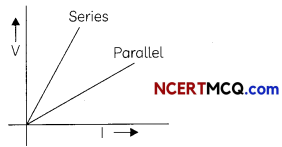Students can access the CBSE Sample Papers for Class 10 Science with Solutions and marking scheme Term 2 Set 4 will help students in understanding the difficulty level of the exam.
CBSE Sample Papers for Class 10 Science Term 2 Set 4 with Solutions
Time allowed: 2 Hours
Maximum Marks: 40
General Instructions:
- All questions are compulsory.
- The question paper has three sections and 15 questions. ALL questions are compulsory.
- Section-A has 7 questions of 2 marks each; Section-B has 6 questions of 3 marks each, and Section-C has 2 case based questions of 4 marks each.
- Internal choices have been provided in some questions. A student has to attempt only one of the alternatives in such questions.
Section – A
Question 1.
In which of the following circuits, heat produced in the resistor or combination of resistors connected to a 12 V battery will be maximum?

OR
Study the following circuit and find out:
(A) Current in 12 Ω resistor. (1)
(B) Difference in the readings of A1 and A1, if any. (1)
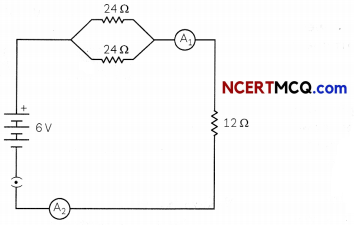
Answer:
Net Resistance in case (i), R = 2Ω
Net Resistance in case (ii), R = 2Ω + 2Ω = 40
Net Resistance in case (iii), \(\frac{1}{R}\) = \(\frac{1}{2}\) + \(\frac{1}{2}\) = 1
⇒ R = 10
We know that, heat is given by the formula:
⇒ H = \(\frac{V^{2}}{R}\) × t
where , H = heat produced
V = potential difference
R = resistance
T = time taken
Since net resistance is the minimum in case (iii) and heat produced is inversely proportional to the resistance, so heat produced will be the maximum in case (iii).
OR
(A) In the circuit, the two resistors of 24 Ω each are connected in parallel to each other. The equivalent resistance of the two resistances in parallel is given by \(\frac{1}{\mathrm{R}_{p}}\) = \(\frac{1}{R_{1}}+\frac{1}{R_{2}}\). where R1 and R2 are the two resistances in parallel.
= \(\frac{1}{24}+\frac{1}{24}\) = \(\frac{2}{24}+\frac{1}{12}\)
As this combination is in series with the 12 Ω resistance, the total resistance in the circuit is given by R = Rp + 12 = 12 + 12 = 24 Ω.
Current is given by / = \(\frac{V}{R}\) = \(\frac{6}{24}\)A = 0.25A R
The current flowing through the 12 Ohm resistance = 0.25 A
(B) Since the same current flows through every part of a circuit having resistances connected in series, both A1 and A2 will give the same reading, 0.25 A
![]()
Question 2.
Why covalent compounds are poor conductors of electricity? Why do covalent compounds have low melting and boiling points?
OR
Why certain compounds are called hydrocarbons? Write the general formula for homologous series of alkanes, alkenes and alkynes and also draw the structure of the member of each series. (2)
Answer:
Covalent compounds are poor conductors of electricity as they do not have charged particles since the electrons are shared between atoms.
Covalent compounds have low melting and boiling points as they have weak inter moLecular forces due to which little energy is required in changing state by overcoming the force of attraction.
OR
Certain compounds are called hydrocarbons because they are formed mainly from carbon and hydrogen.
The general formula for homologous series of alkanes, alkenes and alkynes:
General formula of Alkanes = CnH2n+2
where n = number of carbon atoms
General formula of Alkenes = CnH2n+2
where n = number of carbon atoms
General formula of Alkynes = CnH2n-2
where n = number of carbon atoms
Structure of the first member of each series:
Structure of Alkane (Methane):
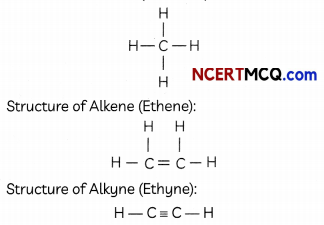
Question 3.
Two types of pollination have been shown in the given diagrams. Identify and differentiate between them ?
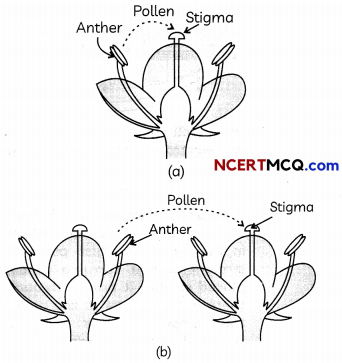
OR
Mention one organism each which shows the following type of reproduction and also write one difference between them.
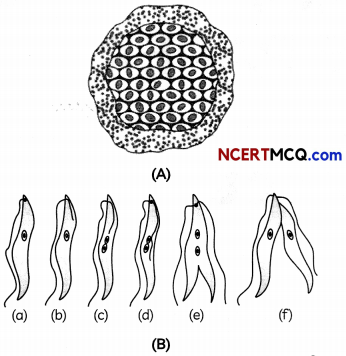
Answer:
Fig (a) represents self pollination and fig. (b) represents cross pollination. Differences between the two are as following:
| Self-Pollination | Cross Pollination |
| (1) Self-Pollination occurs within a flower or two between two on flowers of the same speces. | Cross-pollination occurs between flowers borne different plants of the same species. |
| (2) Pollen grains are produced in small numbers | Pollen grains are produced in small numbers. |
| (3) Flower are not attractive. | Flowers are attractive. |
| (4) There is no wastage of pollen grains and it is economical. | There is wastage of pollen grains and it is not economical. |
Related Theory:
Pollination precedes fertilisation as fertilisation in plants can take place only after pollination carries the male gamete producing pollen grains to the female sex organs.
OR
(A) Plasmodium
(B) Leishmania
Leishmania shows binary fission and Plasmodium shows multiple fission. In binary fission, division of one cell into two similar cells. In multiple fission, many individuals are formed from a single individual.
![]()
Question 4.
How did Mendel’s experiments successfully show that traits may be dominant or recessive? Explain with an example. (2)
Answer:
Mendel took pea plants of two different characters i.e., talL plants and short plants. The first generation of progeny formed were all tail. This shows that traits may be either dominant or recessive, there is no way to obtain in between traits.
Question 5.
The green plants in a terrestrial ecosystem capture about 1% of solar energy. What happens to this energy of the sunlight that falls on the leaves of green plants? (2)
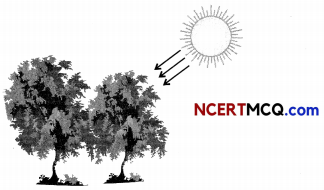
Answer:
1% of total energy from the sunlight that falls on leaves is captured and utilized by plants for photosynthesis.
Related Theory:
As per 10% law, only 10% of energy is transferred to the next trophic level. The remaining 90% energy is used in life processes or some amount goes to the atmosphere as heart.
Question 6.
(A) Carbon is not the only element showing catenation. However, carbon is the only element forming millions of compounds. Comment on the statement. (1)
Answer:
Carbon tends to form millions of compounds as it has two major advantages:
- Small size: Carbon has appropriate size and leads to formation of stable compounds.
- Tetravalent: Carbon has the valency of 4 which enables it to form multiple bonds with similar atoms as well as different atoms.
(B) What will be the formula and electron dot structure of cyclopentane? (1)
Answer:
Cyclonexane is a cyclic compound with formula C6H10 The structure of the compound is represented as:
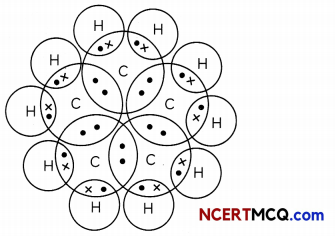
Question 7.
(A) What is the unit of current? Express it in terms of charge and time. (1)
Answer:
The SI unit of current is Ampere. Current I can be expressed in terms of the charge (Q) flowing in time (t) as: I = \(\frac{Q}{t}\)
(B) The following table gives the value of resistivity of some materials:
| Material | Resistivity (Ohm-m) |
| P | 44 × 10– 6 |
| Q | 1010 – 1012 |
| R | 1.62 × 10-6 |
| S | 1015-1017 |
Which material would you suggest to be used in electric heating devices? Give a reason for your choice. (1 )
Answer:
As materials used in electric heating devices are generally made up of alloys having resistivity in the range of 10-8 Ohm-m to 10-6 Ohm-m, material P will be used for electric heating devices as it’s resistivity is more than that of R, which is a metal since its resistivity is very low. Q and S are insulators as they have very high resistivity.
![]()
Section – B
Question 8.
(A) Under what conditions a permanent electromagnet is obtained if a current carrying solenoid is used? (½)
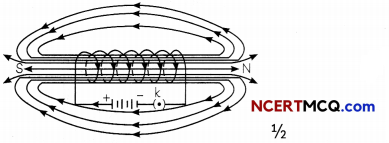
(B) How will you differentiate between an electromagnet and a permanent magnet? (1½)
OR
(A) A magnetic compass needle is placed in the plane of paper near point A, as shown in the figure. In which plane should a straight current carrying conductor be placed so that it passes through A and there is no change in the deflection of the compass? Under what condition is the deflection maximum and why? (½)

(B) In the arrangement shown in the figure, there are two coils wound on a non-conducting cylindrical rod. Initially, the key is not inserted. Then, the key is inserted and later removed. What will be the result of this? (1½)
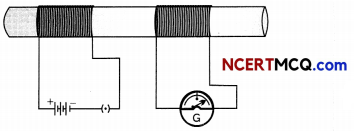
Answer:
(A) If a current carrying solenoid is used, the following conditions must be met to obtain a permanent electromagnet:
- The current via the solenoid must be a direct current.
- A magnetic substance, such as steel, is used to make the rod inside.
- The magnetic substance must have a strong retentivity and not readily lose it.

(B) Difference between permanent magnet and electromagnet:
| Permanent Magnet | Electromagnet |
| Very strong electromagnets cannot be produced. | Very strong electromagnets can be produced. |
| Its strength is-fixed. | Strength can be changed by changing the current through coil. |
| Polarities are fixed | Polarities can be reversed by changing the direction of the current. |
| Cannot be Immediately demagnetized. | Can be demagnetized immediately by stopping the current in the coil. |
| Example of permanent magnet is a bar magnet. | Example of a temporary magnet is solenoid wounded across a nail and connected to a battery. |
OR
(A) The straight current carrying conductor should be placed in the same plane as that of paper. According to the Right hand thumb rule, the direction of the magnetic field is perpendicular to the direction of the current and if a magnetic compass is brought closer to the current carrying conductor, the deflection is maximum. But, when the needle is placed near the point P on the plane as that of the paper as given in the figure, there is no deflection.
(B) A potential difference is induced in coil- 2 whenever the electric current through coil-1 is changing (starting or stopping). Coil-1 is called the primary coil and coil-2 is called the secondary coil. As the current in the first coil changes, the magnetic field associated with it also changes. Thus the magnetic field lines around the secondary coil also change.
Hence, the change in magnetic field lines associated with the secondary coil is the cause of induced electric current in it by a process called electromagnetic induction. Due to this reason, a momentary deflectionin the galvanometer will be observed, which will soon die out when the current flowing through the first coil attains a steady state.
Due to a similar phenomenon, a momentary deflection is again observed in the opposite direction, when the key is removed as in this case, the current is decreasing in the circuit.
![]()
Question 9.
Give reasons:
(A) Testis are located ouside the abdominal cavity. (1)
Answer:
Formation of germ cells or sperms takes place in the testis. These are locted outside the abdominal cavity in the scrotum because sperm formation requires a lower than normal body temperature.
(B) Offsprings formed as a result of sexual reproduction exhibit more variations. (1)
Answer:
The process of sexual reproduction combines DNA from two different individuals. When the germ-cells from two individuals combine during sexual reproduction to form a new individual, it results in re-establishment of the number of chromosomes and the DNA content in the new generation. DNA copying mechanisms creates variations, which are useful for ensuring the survival of the species.
(C) Reproduction is essential for living organisms. (1)
Answer:
Reproduction is one of the important characteristic/function of living things. The ability of an organism to produce young ones of its own kind is not essential for survival but it is essential for the continuity of species, for generations to continue.
Question 10.
A non-biodegradable toxic chemical has entered into the food chain. Which type of food habit would you suggest to a man, vegetarian or non-vegetarian? Explain with the help of a food chain which you would suggest, is advantageous in another aspect. How? (3)
Answer:
Vegetarian food chain will be suggested in case of entry of non-biodegradable toxic chemicals into the food chain.
Non-biodegradable chemicals get concentrated at every trophic level by the process of biological magnification. As the concentration increases with the number of trophic levels in food chain, man will get high concentration of the chemicals in non-vegetarian food chain than in vegetarian food chain.
For Example:
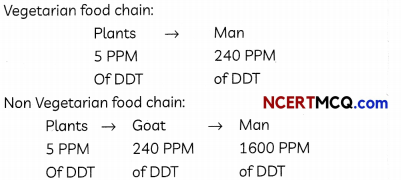
Vegetarian food chain has advantages in terms of available energy to the man because it has less number of trophic Levels. As 90% of energy is Lost in the environment, at every trophic Level, a Lesser number of trophic Levels will resuLt in Lesser energy Loss.
![]()
Question 11.
How is the sex of a new-born determined in humans? (3)
Answer:
In human beings, 23 pairs of chromosomes are present, out of which 22 pairs are exactly the same in both male and female. The 23rd pair of chromosome, known as sex chromosome, is different in males and females.
- Females have a perfect pair of sex chromosome, XX. Therefore, male is known as heterogametic.
- Males have a mismatched pair of sex chromosomes, XY. Therefore, female is known as homogametic.
During spermatogenesis in males, two types of gametes are produced. 50% of gametes produced carry X chromosomes whereas 50% of gametes carry Y chromosome. On the other hand, females produce only one type of ovum containing X chromosomes.
There is an equal probability of fertilization of the ovum with the sperm carrying either X or Y chromosomes. In case the ovum fertilizes with the sperm carrying X chromosomes, the zygote develops into a female (XX) child. Fertilization of the ovum with Y chromosomes carrying sperm result in a male (XY) child.
If the male sex chromosome is X, then the child is female (XX).
If the male sex chromosome is Y, then the child is male (XY).
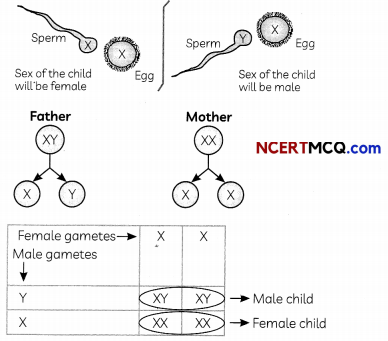
![]()
Question 12.
(A) Draw a diagram to show magnetic field lines due to a bar magnet in a given region. (1)
Answer:
Magnetic field lines around the bar magnet in a region can be represented as given below

(B) What does the divergence of magnetic field lines near the ends of a current carrying straight solenoid indicate? (1)
Answer:
The divergence of magnetic field lines indicates the decrease in strength of the magnetic field near the ends of the solenoid.
Related Theory:
The word divergence means how much the tines of forces are moving away from the source. More the divergence tess is the fietd tine concentration and hence tess is the strength and vice-versa.
(C) Mention the shape of the magnetic field lines around a current carrying straight conductor. (1)
Answer:
The shape of magnetic field lines around the straight current carrying conductor is in the form of concentric circles.
Question 13.
Write tree points of difference between asexual and sexual type of reproduction.
OR
What are variations? Describe why variations are observed in the offspring formed by sexual reproduction. 3
Answer:
| Asexual reproduction | Sexual reproduction |
| In this type of reproduction, the
offspring arises from a single parent. |
The offspring arises from two parents. |
| Gametes are not produced. | Gametes are produced. |
| No fertilisation and zygote formation takes place here. | Gamete formation is followed by fusion of male and female gametes (fertilisation) leading to zygote formation. |
| Meiosis does not occur at anytime during reproduction. | Meiosis occurs at the time of gamete formation. |
| Its role in the origin of new species is minimum. | It plays an important role in the origin of new species. |
OR
The difference between an ideal and a real reality is always variation. A change in data, projected outcomes, or minor changes in production quality are the most common forms of variation. Variation can be detected between individuals of the same species, and it is this difference that is known as variation. During reproduction, some differences are passed down from parents to offspring via genes. Inherited variation is the term for this type of variation. Some variation occurs between the variants as a result of variances in the environment or what an individual performs.
During sexual reproduction, two types of gametes fuse. Although the gametes contain the same number of chromosomes, their DNA is not identical. This situation generates variations among the offsprings. Due to lot of variations, sexual reproduction aLlows species to change to more advanced forms from one generation to the next and speed up evolution.
![]()
Section – C
This section has 02 case-based questions (14 and 15). Each case is followed by 03 sub-questions (A, B and C). Parts A and B are compulsory. However, an internal choice has been provided in part C.
Question 14.
In graph shown below, atomic radius is plotted against the atomic number.

(A) What happens to the atomic radius as you go from Atomic number 3 to 10 and then 11-18? Cite evidence from the graph. (1)
(B) Locate the elements of the periodic table that create major peaks on the graph. (1)
(C) Identify the trend that is demonstrated in the graph. (2)
OR
Using the concepts of periodic table, explain briefly why the pattern is depicted in the graph. Identify the elements that form lowest points in the graph. Explain giving reasons. (2)
Answer:
(A) Atomic radius decreases as we move from atomic number 3 to 10 and 11 to 18. The reason for this is due to increased effective nuclear charge that is due to the addition of electron in the same shell which increases the effective nuclear charge and contracts the radius.
(B) The major peaks observed in the graph are:
X – Hydrogen
Y – Li
Z – Na
P – K
Q – Rb
(C) The atomic radius decreases as we move in a period and increases as we move down in a group.
OR
The trend that is observed here is due to increased effective nuclear charge that is observed in the period. As we move down in a group, there is addition of shells which leads to decrease in effective nuclear charge.
The lowest points in the graph is depicted by noble gases, He, Ne, Ar, Kr and Xe respectively. These elements have complete octet and thereby remain inert. The maximum effective nuclear charge is experienced by these elements and hence their atomic radius is the smallest.
![]()
Question 15.
Components of an electrical circuit or electronic circuit can be connected in series or parallel. Components connected in series are connected along a single conductive path, so the same current flows through all of the components but voltage is dropped across each of the resistances. Components connected in parallel are connected along multiple paths so that the current can split up; the same voltage is applied to each component.
In the circuit I shown below, the two bulbs have been connected in parallel whereas in circuit II, they are connected in series.
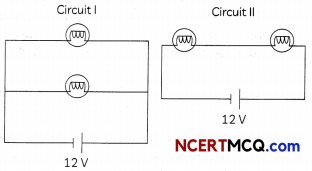
(A) Two bulbs of 60 W and 40 W are connected in parallel. The current through the 60 W bulb is 0.6 A. What will be the current through the 40W bulb? (1)
(B) What will be the total resistance between the points A and B ? (1)
(C) A certain circuit is composed of two parallel resistors. The total resistance is 4 Ohm. One of the resistors is 6 Ohm. What will be the value of the other resistor? (2)
OR
Several electric bulbs designed to be used on a 220 V electric supply, are rated 10 W. How many lamps can be connected in parallel with each other if the maximum allowable current is 5 A? Also draw a VI graph on series and parallel combination of two given resistances R1 and R21. (2)
Answer:
(A) When devices are connected in parallel, the potential difference across them is equal but the currents are in inverse ratios of their resistances.
Let V be the potential difference, I current across 60 W bulb and 12 across 40 W bulb.
P = VI ⇒ V = \(\frac{P}{I}\)
Therefore, V = \(\frac{60}{0.6}\) = 100 V.
The current I2 through 40 W bulb is:
I = \(\frac{P}{V}\)
I = \(\frac{40}{100}\) A = 0.4A
(B) The resistances 1 Ohm and 2 Ohm are in parallel. Their equivalent resistance is
\(\frac{1}{R_{p}}\) = \(\frac{1}{1}+\frac{1}{2}\) = \(\frac{3}{2}\) ⇒ RP = \(\frac{2}{3}\)Ω = 0.67 Ω
This combination is connected in series with the 4 Ohm and 3 Ohm resistances. Therefore, equivalent resistance between A and B is (4 + 0.67 + 3) Ohm or 7.67 Ohm.
(C) The equivalent resistance for resistances connected in parallel is given by:
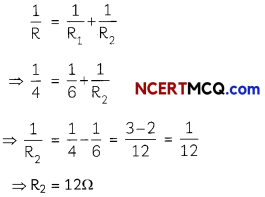
OR
Let the maximum number of bulbs each of 10 W that can be connected in parallel to the 220 V electric supply = n.
The current drawn by one bulb = I = \(\frac{P}{V}\)
= \(\frac{10}{220}\)A or, n = 110.
When resistances are connected in series, their equivalent resistance is more than when they are connected in parallel.
As Resistance = VI slope of V-l graph = Reciprocal of slope of l-V graph, the slope for resistances in series is greater than slope of resistance in parallel.
